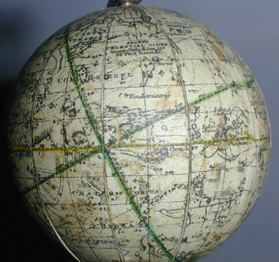Oak Masonic Columns
This item is sold. It has been placed here in our online archives as a service for researchers and collectors.
- Please inquire as to the availability of similar items currently in stock, or use the navigation bar above to browse our site for currently available items.
- Find guidelines for the use of images from georgeglazer.com.
- To see more archived items, view our directory.
- Find information about selling your art and antiques.

 |
 |



Pair of 2-inch Terrestrial and Celestial Globes on Masonic Columns
London: Late 19th Century
Oak columnar stands with bronze capitals
19.5 inches high
Sold, please inquire as to the availability of similar items.
Pair of terrestrial and celestial globes originally made for a Masonic lodge, each in bronze half meridian on a bronze capital (one Corinthian, the other Ionic or Doric), supported by a neoclassical fluted oak column ending in a stepped rectangular plinth. Terrestrial globe with simple cartography, geographic entities outlined in a variety of colors, equator outlined in yellow. Celestial globe with constellations delineated according to classical mythological figures and scientific instruments, celestial circles outlined in a green and yellow.
A pair of globes atop columns are a central part of the iconography of the Masons and were used to decorate their lodges. The columns hearken back to the twin columns which are said to have been placed at the entrance of King Solomon's temple, symbolically linking the Masonic Temple with Solomon's. Generally speaking, the celestial globe is symbolic of the spiritual part of human nature, and the terrestrial globe symbolic of the material side.
A lodge frequently would have a full sized pair on 6-foot columns, with 9- or 12-inch diameter globes. It is common for one of the columns to have a simple Ionic or Doric capital and the other to the pair to have a developed Corninthian capital. Such globes, either in the miniature size or the full size, were sometimes simply painted just showing continents on the world globe and the star motif on the celestial globe. In other examples, such as these, printed globe gores were used. For the miniature, generally one finds globes by George Philip and successor to C. Smith and Sons. For large versions, often a W. & A.K. Johnston pair of terrestrial and celestial were mounted on the large columns.
The Smith family of London globe makers, founded in 1799, produced a variety of floor and table models of globes throughout the 19th century. Charles Smith was joined in business by his son in 1845. According to the cartouche of Smith globes, they were made by J. Smith, and sold by C. Smith, 172 Strand, where they were in operation from 1827 to 1852. The firm later located at 63 Charing Cross and was succeeded at the turn of the 20th century by George Philip & Son, a prominent and prolific London globe maker during the 20th century. For more information on George Philip & Son, please see our Guide to Globe Makers.
Terrestrial Cartouche: "TERRESTRIAL GLOBE/ C. SMITH & SON/ 63 CHARING CROSS."
Celestial Cartouche: "SMITH'S/ CELESTIAL GLOBE/ GEORGE PHILIP & SON Ltd./ 32 Fleet Street. E.C."
Full publication information: George Philip & Son Ltd., 32 Fleet Street , E.C., London. C. Smith & Son, 63 Charing Cross, London.
Reference:
Sinatra, Michael P. "Two Great Columns." Scottish Rite Journal. June 2001. http://www.srmason-sj.org/council/journal/jun01/sinatra.html (17 October 2002)
